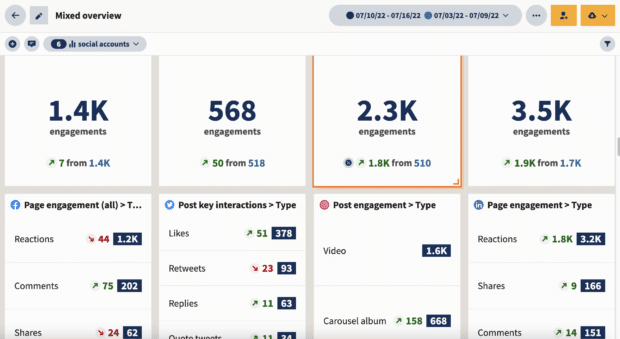Picture a restaurant that makes Michelin-star food but has no menus, servers, or front doors. Makes it hard to eat there, right?
In this example, your marketing content is the high-end cuisine. Just like restaurants need ways for customers to access the food, you need a plan to get that A+ content to your audience.
Content distribution is how you serve your content to your customers.
Because let’s face it: You can create the absolute best content around, but if you don’t have a plan to get it to your customers, it’ll just rot in your kitchen.
In this blog, we’ll teach you how to implement a successful content distribution strategy.
What is content distribution?
Content distribution is the process of promoting and sharing content, like blog posts, videos, or social media updates, to reach a wider audience through various channels and platforms.
There are three main types of content distribution channels: owned, earned, and paid. Each has its own role in your content distribution strategy.
The three types of content distribution channels
Owned
“Owned” channels are ones that your brand has ultimate control over. When you own a channel, you decide what you publish and how you share it with the world.
Owned content channels can include your:
- Website and blog. This includes your standard web copy, like your home and about pages. It also includes any blogs and articles, white papers, or case studies you publish.
- Social media channels. Your social media content is technically your owned content until you put it up on a site that retains ownership of the content, like Quora or Reddit.
- Email marketing. Email marketing is both a channel and a type of content. Email drip campaigns can be an incredibly effective form of advertising. A 2020 Statista survey found that for every U.S. dollar invested in email marketing, brands earned $36 back.
- Educational content. Think ebooks, white papers, webinars, and any how-to content you’ve created. You may host most of these materials on your website, but some, like a webinar done over Zoom, perhaps, can live elsewhere.
- Podcasts. Podcasts are often hosted on third-party apps like Spotify or Google Podcasts. Still, it’s not uncommon for brands to distribute podcasts on their websites.
Earned
Earned channels are ones that your organization does not own or control. This form of content distribution is created and published by a third party.
Examples of earned content distribution can include:
- Mentions, shares, and user-generated content (UGC). Engagement like this shows your followers are actually interested in your content. You can (and should) repurpose this kind of earned content into your social strategy.
- Backlinks. Google loves a backlink, so this is a particularly valuable earned channel. The best way to earn backlinks organically is by posting authoritative information. You can also enter into an agreement to trade links with another brand. That’s generally frowned upon, though, and turns those links into paid content distribution (more on that in the next section).
- Blog features and media coverage. Similar to backlinks, some blogs or articles may mention your brand by name. Roundups, product or service reviews, and ‘best of’ pieces are all great examples of earned content distribution.
In the above example, communications consultants Writer’s Block Solutions shared another piece I wrote for the Hootsuite blog. I didn’t pay for this and I didn’t post it myself — that’s earned content distribution!
While largely outside of your control, these channels can be a good indication of public sentiment surrounding your brand. You can set up alerts or create searches that notify you of brand mentions or other keywords relating to your brand.
Use social listening tools like Hootsuite Listening to keep an eye on what people are saying when you’re not in the room.
Paid
Paid content distribution channels require that you pay to promote your content. Some of these channels are native to the platform you’ll be advertising on, like Twitter, Facebook or Instagram Ads, or Google Display Ads.
You can also run paid media campaigns that use several different platforms. You can even pay an influencer to use their owned channels to distribute content about your brand to their network.
Paid advertising is an integral part of many inbound marketing strategies. When it’s done right, it can really pay off.
Types of paid media channels include:
- Ads. When we talk about paid advertising in a digital sense, we often mean PPC (pay-per-click) or PPM (pay-per-impression) ads. An advertiser pays every time a user interacts with or views their ad. Google Ads, for example, is one of the most popular paid content distribution channels.
- Boosted social posts. These are similar to regular ads, but instead of creating content that only runs as an ad, you pay to increase the reach of your organic social content.
- Influencer marketing. Influencer marketing can take place on pretty much any content distribution channel. You’ll find an influencer who vibes with your brand, then pay them to post about your brand, products, or services on their channels. They can also create content for you to post on your channel.
- Sponsored content or paid UGC. Similar to influencer marketing, but in this case, you’re not paying for the influencer’s audience. Instead, you’re resharing content created by “regular people.”
Best practices for creating your content distribution strategy
Feeling overwhelmed? Relax, we’ve got you!
Here are a few best practices for building your content distribution strategy.
Know your audience
The best way to create content that will earn the widest distribution starts with knowing your audience from the inside out.
Start by creating audience personas and customer journey maps. These help you understand what your audience cares about and what problems they want to solve.
Importantly, this is also when you’ll determine which content distribution channels make the most sense for your audience.
Once you understand your audience, you can create content that speaks directly to them and share it in places they’ll be most likely to find it.
You can use tools like Google Analytics or Hootsuite Listening to gather data about your audience’s demographics, interests, and behavior to tailor your content to their needs.
Set clear goals and KPIs
Before you start creating content, think about what business purpose you want that content to serve. Starting with clear goals and key performance indicators (KPIs) will help you make sure you stay on track.
The goals that you choose will inform the metrics you need to monitor.
Trying to boost your reach on social? You’ll want to keep an eye on things like impressions, follower growth, and social share of voice.
Focused on conversion? Track your conversion rate, bounce rate, and cost-per-click.
If you want to improve customer satisfaction, try counting things like testimonials and customer satisfaction (CSAT) scores.
Create a social media calendar
Creating and posting content on the fly isn’t doing you any favors. Planning in advance using a social media content calendar will keep you organized and on track with your strategy. It’ll also take the guesswork out of which piece of content is distributed where.
Your calendar gives you a birds-eye-view of your content distribution model. It’s the best way to discover any areas you’ve neglected or over-published on.

Try Hootsuite for free. You can cancel anytime.
Create shareable content
If you want people to share your content, make content that people want to share (and yeah, we know that makes it sound easy).
People typically share content that makes them look good or helps others, so keep that in mind while planning your content calendar. Downloadable templates, helpful guides, and valuable stats are all great ways to earn those shares. Whatever you create, make sure it’s easy to digest, visually appealing, and on-brand.
And don’t forget to make it easy for people to share your stuff. Include social sharing buttons on your site and embed codes for easy sharing. Include a call to action that inspires your user to engage.
Distribute your content and tailor it to each platform
Time to start taking advantage of those owned and paid channels! Hopefully, you’ll gain a little attention and some earned distribution as well.
As you distribute your content, remember to adapt it to the features and audience of the platform you’re posting to. This will help you to increase engagement and overall reach.
One webinar can be repurposed in a million ways, but that doesn’t mean sharing the same content on every platform. People like to know what to expect when they pull up a social channel.
Cross-platform campaigns involve content distributed across multiple platforms for one campaign.
The content used in these campaigns will likely differ by platform, but each piece contributes to a shared campaign goal. Having content distribution worked into your campaign strategy maximizes your reach.
A tool like Hootsuite helps you schedule your posts and promotions, so you can take the tedious day-to-day publishing off your plate completely. Hootsuite will even recommend the best times to publish, so you’ll reach your audience when they’re online.

Sign up for your free Hootsuite trial
Measure your results
You need to measure the effectiveness of your content distribution strategy to see what’s working and what’s not. It’s time to go back to the goals and KPIs you set earlier.
If you’re measuring website traffic or conversions, tools like Google Analytics will come in handy. And if you’re running social ads, the native platform tools (like Instagram’s analytics) can help you dig into the numbers.
But if you’re running a cross-platform campaign with social ads and organic posts on multiple platforms, a tool like Hootsuite is a your best bet. You can see all of your analytics, plus handy recommendations for improvements, all in one place.

Find out why social media marketers love Hootsuite
Analyze your data to find which content gets the most engagement, which channels are most effective, and when your audience is most active. This data will help you refine your distribution strategy and create content that resonates with your audience.
Experiment and iterate
Finally, remember that no content distribution strategy is set in stone. Experiment with different channels, content formats, and post times to see what works best for your brand.
Iteration is key. Don’t be afraid to try something new.
Tips for a better content distribution model
Now that we’ve got the basics out of the way, here are some more tips for combining owned, earned and paid channels in a successful content distribution model.
Use paid and organic distribution channels strategically
Paid channels like Google Ads and social media ads can help you reach a wider audience and drive traffic to your website. However, they can also be expensive and ineffective if not used strategically.
Organic channels like SEO, social media, and email marketing can be great for driving traffic and engagement. But they require time and effort to build a loyal audience.
When building your strategy, strike a balance between paid and organic channels that makes sense for your brand and budget.
Collaborate with influencers and partners
Collaborating with influencers and partners can help you reach new audiences.
Just make sure to choose partners who align with your brand values and make sense for your audience. Building a mutually beneficial partnership can pay off in the long run.
Repurpose and recycle content
Creating content from scratch can be time-consuming and resource-intensive. That’s why it’s important to repurpose and recycle your existing content into different formats and channels.
You can turn a blog post into a video, a podcast into a blog post, or a social media post into an email newsletter. Not only does this save time and effort, but it also ensures that your content reaches a wider audience.
Save time managing your social media presence with Hootsuite. From a single dashboard you can publish and schedule posts, find relevant conversions, engage the audience, measure results, and more. Try it free today.






